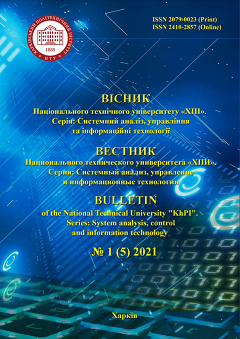MODELING OF A SYSTEM FOR AUTOMATIC REGULATION OF THE TENSION MODE IN THE ROUGHING GROUP OF STANDS OF A CONTINUOUS SECTION MIL
DOI:
https://doi.org/10.20998/2079-0023.2021.01.11Abstract
The subject of the research is automatic control system modeling features for tensioning of stands roughing group, which takes into account changes in the rolling speed at exit of the previous stand and entrance to the next stand. Control systems for high-speed rolling on section mills are the most critical systems, since the trouble-free operation of rolling mill largely depends on their work. Rolling speed control is understood to mean tension regulation in the roughing group of stands and stabilization of the rolling loop in the finishing groups. The influence of such technological factors as uneven heating of blanks, change in the crimping mode in stands, etc. leads to the appearance of tension or back-up forces, deviation of rolled loop from the specified values. Tension rolling, in contrast to loop rolling, is a stable rolling mode. However, (at significant values of tension in the rolled products) such a rolling mode leads to different thicknesses of the finished product. The loop rolling mode is an unstable mode and is impossible without automatic control systems. Both in the tension rolling mode and in the free rolling mode with a loop, it is necessary to study automatic control systems in order to determine the possibilities of compensating for disturbing influences and obtaining rolled products of the given accuracy. Therefore, the main task of the automatic control system is to maintain the rolling mode with the lowest possible tension. To achieve this goal, direct control of the tension of the rolled strip with modern technical means is rather difficult, and the operation of tension control systems is based on indirect methods of measuring it, and the study of the system efficiency is reduced to modeling the process itself. The developed model consists of three stands and two inter-stand spaces, since it takes into account changes in rolling speed at the exit of previous stand and the entrance to the next stand. It is due to this that adequate simulation results are obtained that are close to the real rolling process.
Keywords: automation, rolls, stand, inter-stand spacing, modeling, loop tension, rolling mill, roughing group.
References
Marinich I. A, Serdyuk O. Yu., Gram O. O., Romanov S. O. Osoblivosti` modelyuvannya rezhimu natyagu chornovoyi grupi kli`tej neperevnogo sortovogo stanu [Features of modeling tension mode of rough group of stands of continuous varietal condition]. Rozvitok promislovosti` ta suspi`l`stva. Tezy dopovidey mizhnarodnoyi naukovo-praktychnoyi konferentsiyi (17-20 listopada 2020r., Krivij Ri`g) [Development of industry and society. Abstracts of reports of the international scientific and technical conference (November 17-20, 2020, Kryvyi Rih)]. Kryvyj Rih: KNU Publ., 2020. p. 259.
Solod V. S. Beneczkij A. G. Mamaev A. N. Modelirovanie proczessa sortovoj prokatki s pomoshh`yu programmnogo kompleksa «SORTPRO» [Modeling section rolling process using the "SORT-PRO" software package]. Obrabotka materialov davleniem, 2010, no. 3 (24), pp. 60–63.
Karandaev A. S., Khrampshin V. R. Andryushin I. Yu., Golovin V. V. Matematicheskoe modelirovanie vzaimosvyazanny`kh e`lektromekhanicheskikh sistem mezhkletevogo promezhutka shirokopolosnogo stana goryachej prokatki [Mathematical modeling of interconnected electromechanical systems of inter-stand spacing of wide-strip hot rolling mill]. Izvestiya vuzov. E`lektromekhanika. 2009, no. 1, pp. 12–20.
Egorov A. P., Egorov V. S., Khanin M. I., Zvory`kin V. B. Modelirovanie sistemy` upravleniya tolshhinoj polosy` neprery`vnogo shirokopolosnogo stana goryachej prokatki: uchebnoe posobie [Modeling of strip thickness control system for continuous broadband hot rolling mill: Study guide]. Dnepropetrovsk; IPK MK Publ., 2000. 125 p.
Voskan`yancz A. A. Avtomatizirovannoe upravlenie proczessami prokatki: uchebnoe posobie [Automated control of rolling processes: Study guide]. Moscow: MGTU im. N.E`.Baumana Publ., 2010. 85 p.
Uchitel` A.D., Tkachenko G. I., Khizhnyak V. Ya., Mokhnaty`j A. V. Sredstva i sistemy` avtomatizaczii v gorno-metallurgicheskom komplekse [Automation tools and systems in mining and metallurgical complex]. Kiev: VPK «Ekspres-Poli`graf» Publ., 2013. 184 p.
Grudev A. P., Mashkin A. F., Khanin M. I. Tekhnologiya prokatnogo proizvodstva [Rolling production technology]. Moscow: Metallurgiya Publ., 1994. 651p.
Babenko M. A., Korotchenkov V. M., Nosikov V. L. Izmerenie skorosti vrashheniya valkov prokatny`kh kletej na osnove mikroproczessornoj tekhniki [Measurement of rotation speed of rolling stands rolls based on microprocessor technology]. Metallurgiya i gornorudnaya promy`lennost`. 2002, no. 1, pp. 43–45.
Babenko M. A., Korotchenkov V. M., Nosikov V. L. Mikroproczessorny`j datchik nalichiya metall v valkakh prokatnoj kleti [Microprocessor-based sensor for presence of metal in rolling stand rolls]. Metallurgiya i gornorudnaya promy`shlennost`. 2003, no. 1, pp. 49–53.
Shokhin V. V., Andreev A. I., Morkovina P. S. Modelirovanie prokatnogo stana s ispol`zovaniem fizicheskikh i matematicheskikh modelej [Rolling mill simulation using physical and mathematical models]. E`lektrotekhnicheskie sistemy` i kompleksy`. 2017, no. 2(35), pp.13–18.
Shokhin V. V., Permyakova O. V., Korotkova E. V. Modelirovanie vzaimosvyazannogo chastotno-reguliruemogo e`lektroprivoda prokatnogo stana [Simulation of interconnected variable frequency drive of rolling mill]. Mezhdunar. sb. nauch. trudov. Vip. 21 [Int. collection of scientific. works Vol. 21]. Magnitogorsk: gos. tekhn. unta im. G.I. Nosova Publ., 2013, pp, 70–75.
Cherny`kh I. V. Modelirovanie e`lektrotekhnicheskikh ustrojstv v Matlab, SimPowerSystems, Simulink [Simulation of electrical devices in Matlab, SimPowerSystems, Simulink]. Moscow: DMK Press Publ., 2008. 288 p.
Downloads
Published
How to Cite
Issue
Section
License
LicenseAuthors who publish with this journal agree to the following terms:
- Authors retain copyright and grant the journal right of first publication with the work simultaneously licensed under a Creative Commons Attribution License that allows others to share the work with an acknowledgement of the work's authorship and initial publication in this journal.
- Authors are able to enter into separate, additional contractual arrangements for the non-exclusive distribution of the journal's published version of the work (e.g., post it to an institutional repository or publish it in a book), with an acknowledgement of its initial publication in this journal.
- Authors are permitted and encouraged to post their work online (e.g., in institutional repositories or on their website) prior to and during the submission process, as it can lead to productive exchanges, as well as earlier and greater citation of published work (See The Effect of Open Access).


